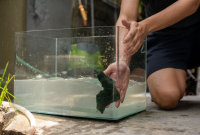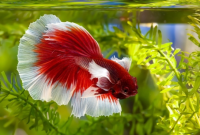In the realm of aquarium keeping, the phrase “water conditions” and the intricacies of the “nitrogen cycle” are paramount. To create a thriving aquatic environment for your beloved fish, it is imperative to comprehend these essential concepts. This comprehensive guide will delve deep into the intricacies of maintaining proper water conditions and understanding the nitrogen cycle in your aquarium.
Water Conditions: The Foundation of Aquatic Health
What are Water Conditions?
Water conditions refer to the physical and chemical properties of the water within your aquarium. These conditions play a pivotal role in determining the overall health and well-being of your aquatic inhabitants. Understanding and maintaining the optimal water conditions are crucial for the longevity and vibrancy of your underwater ecosystem.
Parameters to Consider
1. Temperature
The water temperature in your aquarium is a fundamental factor affecting your fish’s metabolism, digestion, and overall behavior. Different species thrive at different temperatures, so it is essential to research and provide the appropriate range for your fish.
2. pH Level
pH measures the acidity or alkalinity of your aquarium water. It is crucial to maintain a stable pH level as sudden fluctuations can stress your fish and disrupt the nitrogen cycle. Research your fish species to determine their preferred pH range.

3. Ammonia Levels
Ammonia is highly toxic to fish and is a byproduct of fish waste and decaying organic matter. Keeping ammonia levels close to zero is imperative for a healthy aquarium. The nitrogen cycle plays a significant role in ammonia regulation, as we’ll explore in the next section.
4. Nitrate and Nitrite Levels
Nitrate and nitrite are also products of the nitrogen cycle. Elevated levels of these compounds can be harmful to fish. Proper filtration and regular water changes are essential to keep nitrate and nitrite levels in check.
Importance of Water Testing
Regularly monitoring your aquarium’s water conditions is vital. Invest in high-quality test kits to check pH, ammonia, nitrite, and nitrate levels. This proactive approach allows you to identify and rectify any issues before they pose a threat to your aquatic friends.

The Nitrogen Cycle: Nature’s Filtration System
What is the Nitrogen Cycle?
The nitrogen cycle is a natural biological process that occurs in all aquatic environments, including your aquarium. It is a life-sustaining mechanism that converts harmful ammonia into less toxic compounds, ultimately maintaining a healthy ecosystem.
Stages of the Nitrogen Cycle
1. Ammonia Production
The nitrogen cycle begins with the production of ammonia, primarily from fish waste, uneaten food, and decaying plant matter. Ammonia is highly toxic to fish and can quickly lead to illness or death if not addressed promptly.
2. Nitrite Formation
Beneficial bacteria, known as Nitrosomonas, convert ammonia into nitrites. Nitrites are also harmful to fish but less so than ammonia. During this stage, the aquarium starts to establish its biological filtration.
3. Nitrate Production
Another group of beneficial bacteria, Nitrobacter, then converts nitrites into nitrates. While nitrates are less toxic than ammonia and nitrites, high levels can still harm fish. This is where routine water changes come into play, removing excess nitrates.
4. The Role of Plants
Live aquatic plants can play a significant role in the nitrogen cycle by absorbing nitrates as a nutrient source. Incorporating plants into your aquarium can help maintain water quality and reduce the frequency of water changes.
Cycling Your Aquarium
Establishing a stable nitrogen cycle is the key to maintaining proper water conditions. Cycling your aquarium involves introducing a source of ammonia, such as fish food or pure ammonia solution, and allowing the beneficial bacteria to establish themselves. This process can take several weeks but is crucial for the long-term health of your aquarium.
Price Table:
Here’s a recommended setup for maintaining proper water conditions and the nitrogen cycle:
| Item | Description | Price |
|---|---|---|
| Aquarium Heater | To maintain the desired water temperature | $25 – $50 |
| pH Test Kit | For monitoring and adjusting pH levels | $10 – $20 |
| Ammonia Test Kit | To keep ammonia levels in check | $10 – $20 |
| Biological Filtration System | Ensures efficient conversion in the nitrogen cycle | $30 – $100 |
| Live Aquarium Plants | A natural way to reduce nitrates | $5 – $20/plant |
| Water Conditioner | For dechlorinating tap water and detoxifying ammonia | $5 – $15 |
Investing in these items and following the guidelines outlined in this article will help you create an optimal environment for your aquarium.
Conclusion
Maintaining proper water conditions and understanding the nitrogen cycle are essential aspects of responsible aquarium ownership. By providing the ideal environment and allowing the nitrogen cycle to work its magic, you’ll ensure a healthy and thriving aquatic ecosystem for your fish.
Remember to regularly test your water parameters, perform necessary water changes, and consider the specific needs of your fish species. With diligence and a solid understanding of these fundamental concepts, you’ll create an aquatic haven that will amaze and delight both you and your aquatic companions.



